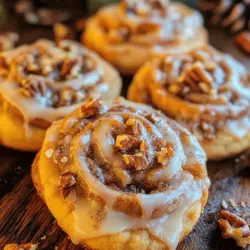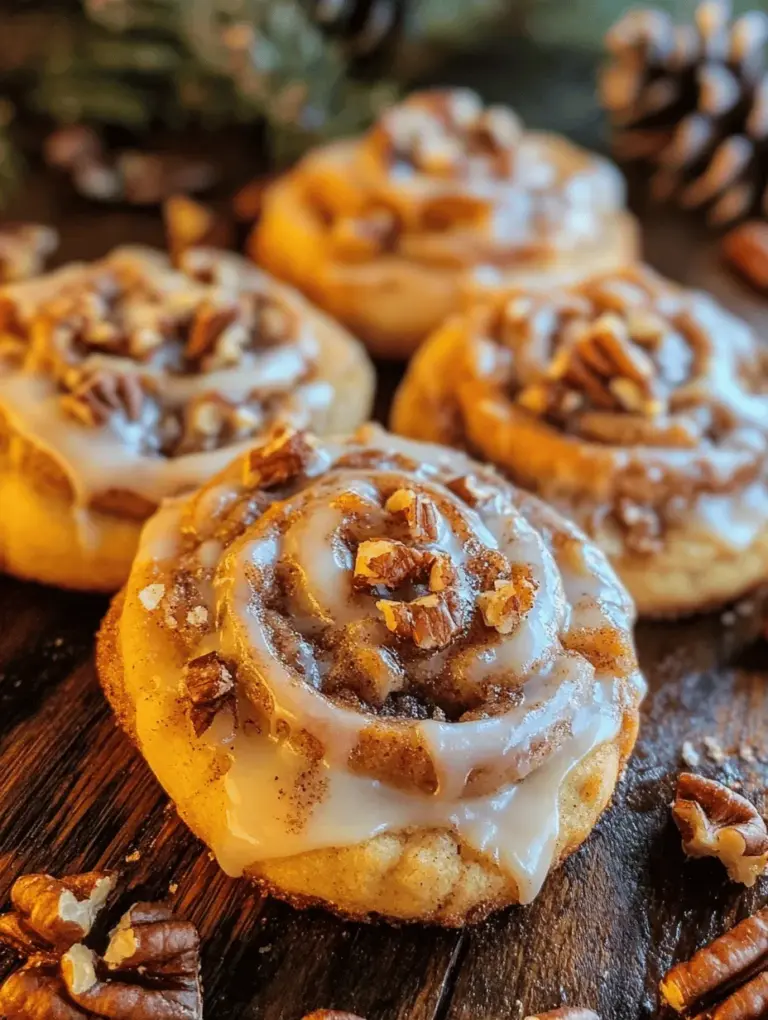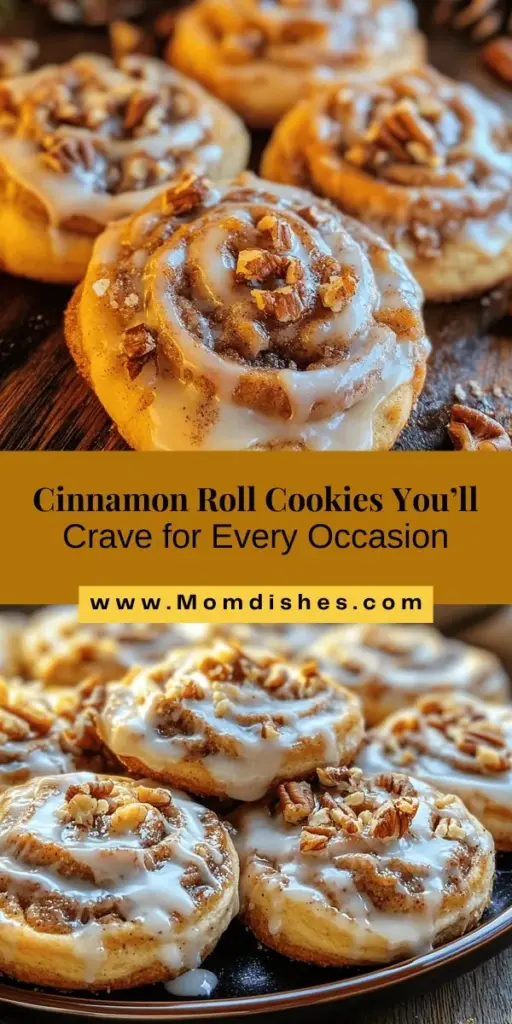Introduction
Cookies hold a special place in the hearts of dessert lovers everywhere. Their versatility and ease of preparation make them a beloved choice for a variety of occasions, from casual get-togethers to holiday celebrations. However, what if we could elevate the classic cookie experience with a delightful twist? Enter Cinnamon Roll Cookies—a scrumptious fusion that marries the comforting flavors of traditional cinnamon rolls with the irresistible charm of cookies.
These delightful treats capture the essence of freshly baked cinnamon rolls, complete with a gooey filling and a sweet glaze, all while maintaining the soft and chewy texture of your favorite cookie. Imagine biting into a warm, cinnamon-spiced cookie that oozes with flavor, giving you the best of both worlds. Whether you’re hosting a brunch, looking for a unique dessert for a gathering, or simply treating yourself on a lazy afternoon, these Cinnamon Roll Cookies are sure to impress.
Understanding the Ingredients
To create the perfect Cinnamon Roll Cookies, it’s essential to understand the role each ingredient plays in the recipe. A successful cookie relies not only on the right proportions but also on the quality of the ingredients. Here’s a closer look at the key components:
All-Purpose Flour
All-purpose flour serves as the foundation for any cookie recipe. It provides structure and texture, allowing the cookies to maintain their shape while baking. When measuring flour, it’s crucial to use the spoon-and-level method to avoid packing it too tightly, which can lead to dry or dense cookies. The right amount of all-purpose flour ensures that our Cinnamon Roll Cookies are soft and chewy, just like we want them.
Baking Powder and Baking Soda
Both baking powder and baking soda are essential leavening agents that help cookies rise and achieve a light, airy texture. Baking soda is a base that requires an acid to activate, while baking powder contains both acid and base components, allowing it to work independently. In our Cinnamon Roll Cookies, the combination of these leavening agents helps create the optimal texture, making them fluffy and delicious.
Ground Cinnamon
As the star flavor of these cookies, ground cinnamon brings warmth and sweetness, reminiscent of the classic cinnamon roll experience. It infuses the dough with a delightful spice that tantalizes the taste buds. Be sure to use fresh ground cinnamon for the best flavor; its potent aroma and taste are what truly set these cookies apart.
Butter
Butter is a key player in baking, contributing to the flavor and texture of cookies. For this recipe, unsalted butter is preferred, as it allows for better control over the saltiness of the final product. Creaming the butter with sugars is a crucial step that incorporates air into the mixture, resulting in a light and fluffy cookie. Make sure the butter is at room temperature for optimal creaming, which helps achieve the right consistency.
Sugars
In this recipe, we’ll be using both granulated and brown sugar. Granulated sugar adds sweetness and helps create a crisp texture, while brown sugar, with its molasses content, contributes moisture and a rich flavor. The combination of the two creates a balanced sweetness and enhances the overall taste of the cookies.
Egg and Vanilla Extract
Eggs serve multiple purposes in baking; they provide moisture, richness, and act as a binder, helping to hold the cookie together. Additionally, vanilla extract enhances the flavor profile, adding a lovely aromatic quality that complements the cinnamon perfectly.
Optional Nuts
While not essential, adding nuts—such as pecans or walnuts—can elevate the texture and flavor of the Cinnamon Roll Cookies. Chopped nuts offer a delightful crunch that contrasts beautifully with the soft cookie, making each bite even more satisfying. If you choose to include nuts, consider toasting them lightly to enhance their flavor before adding them to the dough.
Preparation Steps of Cinnamon Roll Cookies
Now that we understand the essential ingredients, let’s dive into the preparation process. Each step is vital in achieving the ultimate Cinnamon Roll Cookies, ensuring that they come out perfectly every time.
Preheating the Oven
Before you start mixing your ingredients, it’s crucial to preheat your oven to the recommended temperature. Preheating ensures that your cookies bake evenly and develop a lovely golden-brown color. A properly heated oven helps the cookies rise correctly and achieve the desired texture. Aim for a temperature of 350°F (175°C) for this recipe.
Mixing Dry Ingredients
Begin by whisking together the dry ingredients—flour, baking powder, baking soda, ground cinnamon, and a pinch of salt—in a separate bowl. This step is essential for evenly distributing the leavening agents and spices throughout the flour. By taking the time to mix the dry ingredients thoroughly, you set the stage for a consistent flavor and texture in your cookies.
Creaming Butter and Sugars
In a large mixing bowl, cream together the room-temperature unsalted butter, granulated sugar, and brown sugar until the mixture is light and fluffy. This process typically takes about 3-5 minutes with an electric mixer. Creaming incorporates air into the butter, which is crucial for the cookies to rise properly. The sugars dissolve into the butter, creating a smooth and creamy base that enhances the overall texture of the cookies.
Incorporating Egg and Vanilla
Once the butter and sugars are well combined, add in the egg and vanilla extract. Mix until fully incorporated, scraping down the sides of the bowl as needed. The egg contributes moisture and richness, while the vanilla extract enhances the flavor profile, making your cookies even more irresistible.
Combining Dry and Wet Ingredients
Next, gradually add the dry ingredient mixture to the wet ingredients, mixing on low speed until just combined. Be careful not to overmix, as this can lead to tough cookies. The goal is to combine the ingredients until no visible flour remains, resulting in a soft and slightly sticky dough.
Adding Nuts
If you decide to incorporate nuts, now is the time to fold them into the dough gently. Use a spatula to combine them evenly, ensuring that each cookie gets a delightful crunch. If you’re using chocolate chips or any other mix-ins, this is also the perfect moment to add those for an extra touch of flavor.
Creating the Cinnamon Filling
One of the defining features of Cinnamon Roll Cookies is their delectable cinnamon filling, which adds an extra layer of flavor and richness to the cookies. The filling is what truly sets these cookies apart from traditional cookie recipes—it gives them that signature cinnamon roll taste.
To prepare the cinnamon filling, you’ll typically mix together ground cinnamon, softened butter, and brown sugar until you achieve a paste-like consistency. This mixture will be swirled into the cookie dough, resembling the classic cinnamon roll spiral. The filling’s sweetness and warmth create a delightful contrast to the cookie’s soft texture.
Importance of the Filling in Flavor Development
The cinnamon filling is not just an added bonus; it plays a crucial role in flavor development. As the cookies bake, the filling caramelizes and seeps into the dough, creating pockets of gooey goodness that enhance each bite. The warm cinnamon aroma wafting through your kitchen as the cookies bake is an experience in itself, evoking memories of bakeries and coffee shops.
In conclusion, the preparation of Cinnamon Roll Cookies is an engaging and rewarding process. From understanding the key ingredients to carefully following each step, you are on your way to creating a batch of cookies that will impress friends and family alike. Stay tuned for the next part of this article, where we will delve deeper into the baking process and provide tips for achieving the best results with these delightful treats.
{{image_1}}
The Best Cinnamon Roll Cookies
Ingredients for the Filling
The filling of these cookies is what truly elevates them to the next level, transforming a traditional cookie into a delightful cinnamon roll experience. The two star ingredients here are brown sugar and cinnamon. Brown sugar not only adds sweetness but also brings a rich, molasses-like flavor and moisture that keeps the cookies soft. Its slightly sticky texture helps the filling adhere to the dough, creating a delicious swirl when you bite into the finished cookie.
Cinnamon, on the other hand, is the quintessential spice that ties this recipe together. Its warm, aromatic presence is synonymous with comfort and indulgence. The combination of these two ingredients creates a filling that is sweet, spicy, and utterly irresistible.
Mixing Techniques to Achieve the Right Consistency
Achieving the right consistency for your filling is crucial for the perfect cinnamon roll cookies. Start by combining the brown sugar and cinnamon in a small bowl. The ideal ratio is typically two parts brown sugar to one part cinnamon, but you can adjust this based on your taste preferences.
Mix these dry ingredients thoroughly to ensure that the cinnamon is evenly distributed throughout the brown sugar. This step is essential to avoid clumps of cinnamon in your filling, which can lead to uneven flavor distribution in the cookies. If you want a richer flavor, consider adding a touch of softened butter to the mixture, which can help create a paste-like consistency that is easier to spread.
Assembling the Cookies
Now that you have your dough and filling prepared, it’s time to assemble the cookies. Follow this step-by-step guide to form them perfectly:
1. Prepare the Dough: After chilling your cookie dough (as per the earlier instructions), take it out and let it rest at room temperature for about 5 minutes. This will make it easier to roll out.
2. Roll Out the Dough: On a lightly floured surface, roll the dough into a large rectangle, about 1/4 inch thick. Use a rolling pin to ensure an even thickness. Make sure the dough doesn’t stick to the surface; add more flour if necessary.
3. Add the Filling: Evenly sprinkle the cinnamon filling mixture over the entire surface of the rolled-out dough. Leave a small border around the edges to prevent the filling from spilling out when you roll it up.
4. Roll Up the Dough: Starting from one of the longer sides of the rectangle, carefully roll the dough into a tight log. Be gentle but firm to maintain an even roll throughout.
5. Seal the Cookies: Once rolled, pinch the seam to seal it. This step is important to ensure the filling doesn’t escape during baking. If you have any excess dough at the ends, trim it with a sharp knife.
6. Slice the Cookies: Using a sharp knife or a bench scraper, slice the log into equal sections, about 1-inch thick. You should have roughly 12-15 slices.
7. Place on Baking Sheet: Line a baking sheet with parchment paper and place the cookies on it, leaving space between each to allow for spreading.
Baking Process
Baking these cookies is simple, but attention to detail is key to achieving the perfect texture and flavor.
1. Preheat the Oven: Preheat your oven to 350°F (175°C). This step is crucial as it ensures that the cookies bake evenly.
2. Baking Time: Place the baking sheet in the preheated oven and bake for about 10-12 minutes. Keep an eye on them, as baking times can vary based on your oven and the thickness of the cookies. The edges should be lightly golden, while the centers may look slightly underbaked. This is normal, as they will continue to cook on the baking sheet after being removed from the oven.
3. Cooling Tips: Once baked, allow the cookies to cool on the baking sheet for about 5 minutes. This helps them firm up. After that, transfer them to a wire rack to cool completely. Cooling on a wire rack is essential because it prevents steam from building up underneath the cookies, which could make them soggy.
Making the Icing
No cinnamon roll cookie is complete without a luscious icing to drizzle on top. The icing not only adds a sweet finishing touch but also enhances the overall presentation.
1. Ingredients for the Icing: For the icing, you will need powdered sugar, milk (or cream for a richer flavor), and vanilla extract. The powdered sugar provides the sweetness and structure, while the milk helps achieve a smooth, pourable consistency. Vanilla extract adds a depth of flavor that complements the cinnamon perfectly.
2. Mixing the Icing: In a medium bowl, whisk together 1 cup of powdered sugar, 2 tablespoons of milk, and 1/2 teaspoon of vanilla extract. Adjust the milk quantity until you reach your desired consistency; for a thicker icing, use less milk, and for a thinner icing, add more. Mix until there are no lumps, ensuring a smooth, creamy texture.
Drizzling Icing and Final Presentation
Once your cookies have cooled completely, it’s time to add the finishing touch with the icing.
1. Icing Application: You can drizzle the icing over the cookies using a spoon or a piping bag. For a neat look, place the icing in a piping bag and cut a small hole in the end. This allows for more control when applying the icing.
2. Visual Appeal: Drizzle the icing over the cookies in a zigzag pattern or create concentric circles for a visually appealing effect. The white icing against the golden-brown cookies creates a beautiful contrast that is sure to impress.
3. Serving Suggestions: Serve these cookies warm or at room temperature. They pair wonderfully with a cup of coffee, tea, or even a glass of milk. For an added touch, consider sprinkling some chopped nuts or a dusting of cinnamon over the icing for extra flavor and texture.
Nutritional Information
Understanding the nutritional aspects of your baking can help you enjoy these cookies while being mindful of your dietary needs.
1. Overview: Each cinnamon roll cookie contains approximately 150 calories, with around 6 grams of fat, 20 grams of carbohydrates, and 1 gram of protein. The icing adds an additional 30-50 calories per cookie, depending on how much you use.
2. Dietary Considerations: While these cookies are a delightful treat, those watching their sugar intake may want to consider alternatives such as using sugar substitutes or reducing the amount of icing used.
3. Healthier Variations: For a healthier twist, you could use whole wheat flour in place of all-purpose flour, reduce the sugar in the filling, or substitute some of the butter with unsweetened applesauce. These adjustments can help make this indulgent treat a bit more guilt-free.
Conclusion
Baking is not only about creating delicious treats but also about the joy of sharing them with family and friends. These cinnamon roll cookies offer a delightful combination of flavors and textures that are sure to please everyone. The warm, comforting aroma that fills your kitchen while they bake will evoke memories of cozy mornings and festive gatherings.
As you experiment with this recipe, feel free to add your own twists—try incorporating nuts, raisins, or even a hint of orange zest in the filling for a unique flavor profile. These cookies are not just a recipe; they are an invitation to explore and create in the kitchen.
Make these cinnamon roll cookies a staple in your baking repertoire, and enjoy the rich flavors and delightful textures that make them a true treat for any occasion. Happy baking!


